This September, I was incredibly fortunate to spend a month on the Calf of Man—and what an experience it was!
Calf of Man Autumn Volunteer Experience
Seal pup Chub lounging in a puddle at South Harbour.
My name is Maia, and I was recently offered the Autumn Migration Volunteer position, assisting the bird team with their daily duties, including ringing and census work. I first came across the role on social media and was immediately drawn to the unique opportunity to witness island migration first-hand and experience life at a remote bird observatory. What excited me most was the diversity of species I might encounter—shearwaters to pipits, raptors to finches—it promised to be an unforgettable month, and it certainly didn’t disappoint.
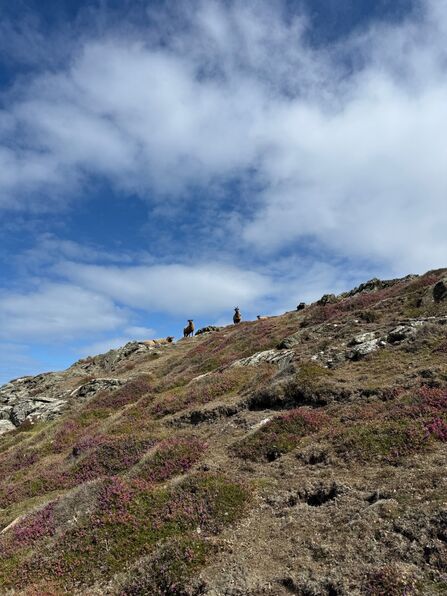
Sheep looking down over Creg Veanagh, Calf of Man.
Whilst I regularly ring at an observatory back home (Sandwich Bay Bird Observatory, Kent), it was a completely different experience on the Calf. I arrived on the 2nd, since the boat crossing on the 1st was cancelled due to bad weather. After a choppy crossing, escorted by Gannets and gulls, the two seal volunteers, Bea and Alex, Lara, and myself arrived at the little harbour on the south coast of the island. By September, heather finishes its flowering season, with peak bloom being in August, so it was lovely to see the island in its final weeks of being purple. After joining in with the ringing, Eleanor and I went and did the north census route, where we caught a glimpse of a small pod of Risso’s dolphins. After the 20:00 evening log, sharing all our sightings, Eleanor and I ventured back out to the cliffs of South Harbour, and searched for stargazing Manx shearwater chicks. It was a successful evening, with over 20 chicks caught and a re-trap adult. Manxies were a first for me, having never ringed seabirds, so it was an exciting start to my time on the Calf.
On the 3rd, a Garden Warbler in the nets made for a notable record on the island. I found it especially interesting to learn that Garden Warbler is a description species on the Isle of Man—though Calf has a description exemption. Having ringed so many in Kent, this came as quite a surprise. It was also a good reminder, like the stark absence of Woodpigeons and Blue Tits, of just how different bird assemblages can be across regions. To top off the day, an Osprey drifting over the observatory in the evening was a fantastic and unexpected bonus.
The weather allowed a few days of good ringing, with highlights including Spotted Flycatchers, Tree Pipit, and Goldcrests, as well as good numbers of migrating Robins. One of the best aspects for me as a ringer was the variety of trapping methods in use: Heligolands, a crow trap, spring traps, and a highly effective Meadow Pipit trap. Before arriving on Calf, I had only ringed a handful of Meadow Pipit pulli, but the front field trap proved incredibly productive. It really highlighted just how many pipits were on the move as the month progressed. Joined by the seal team, we had another enjoyable night of Manxies on the 6th, catching a decent number of fluffy chicks!
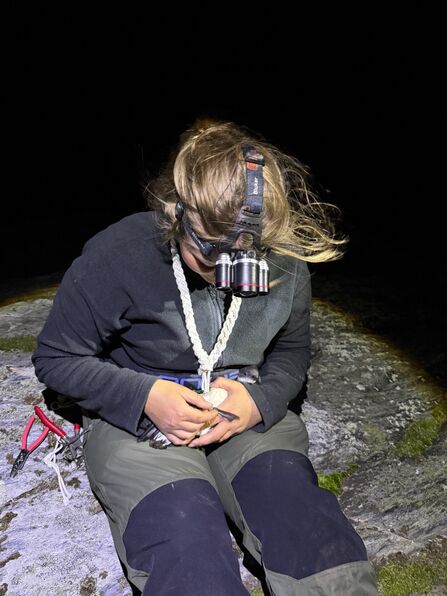
Maia Jones ringing a Manx Shearwater.
During census on the 7th, myself and the seal team found an Osprey at Gibdale and on the 9th, I found a Short-eared owl, the first recorded on the island since May. The owl initially flew off from the heather above Gibdale, almost exactly where the Osprey had been days before, and re-appeared at Cow Harbour causing the Oystercatchers to go up in a noisy flurry. Despite the weather taking a turn, census and ringing continued. Spotted and Pied Flycatchers were regularly sighted (including from my bedroom window), good numbers of wagtails caught, and another evening catching Manxies on the 9th. I still hadn’t got used to the regular company of Chough, or daily glimpses of a ringtail Hen Harrier over the heather.
On the 12th, it was my turn to make the most of the windy weather and do some early morning sea watching. Despite losing most of the sensation in my fingers and ears, I recorded Kittiwake, Auk sp., Gannet passage, and Arctic Skua – a lifer for me. Three Common Scoters hugging the coast marked the end of my chilly morning. A young female Sparrowhawk in the Heligoland that afternoon became the first full-grown raptor I have ringed, and was the first of a few over the month. A Humming-bird Hawk-moth on the buddleia in front of the observatory was also a pleasure to watch.
The Calf runs several colour ringing schemes for a variety of species, including Shags, gulls, Stonechats, and wagtails. Colour ringing is a valuable tool for tracking bird movements without needing to recapture individuals—allowing for long-term monitoring across large distances. One great example was a Wheatear ringed in the nest earlier this year, which was spotted three months later in Dunkirk, France!
One of my favourite afternoon activities was spring-trapping Rock Pipits along the cliffs. I love their dusty grey-brown plumage and how such a small, unassuming bird thrives in the harsh, windswept environment of cliffs and rocky shorelines. Each bird was fitted with a standard metal ring and a unique alpha or alpha-numeric code colour ring; white writing on a black ring.
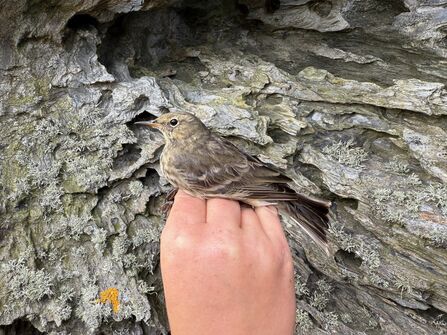
Rock Pipit in the hand (c)Maia Jones.
On the 14th, almost everyone’s favorite grey seal was born – ‘Chub’. Chub’s mum, affectionately named Fatty due to her roundness, had claimed a small puddle at South Harbour. The team had been keeping an eye on her for days, so it was exciting when she finally popped! Chub and mum were very accustomed to people, being so close to the jetty, so it was nice to see a little pup so close up.
My birthday happened to fall in the middle of my time on Calf, and it was most enjoyable! Despite the high winds, I had a nice afternoon census, where I saw a pretty Greenland Wheatear, and was treated to a lovely Kiwi bird shaped cake made by the talented Alex!
It wasn’t all about birds on Calf! Windy and rainy days meant a lot of time inside, spent uploading historic nest records and chipping in with chores. At times the rest of us would help the estate team, who were often out digging drains, checking traps and cameras, and fixing things up. I got up to all sorts – fixing wire mesh to slippery boardwalks at the nets, collecting in decoy Puffins, and shifting shingle to fill the bumps in the vehicle tracks. At the end of the month, the drystone wallers were out on the Calf, and it was impossible to spot where they had been fixing gaps.
The weather continued to be a bit wet and wild for a few days, but we managed to get a few nets and traps open. On the 19th Eleanor heard a brief call out front whilst checking traps – a Rosefinch! After a mad rush, the young bird was located and later found its way in to the nets. A lifer for many of us, it was great to get a brief view of the bird high in the trees, food around its beak (hence its nickname of ‘grot’finch), but it was even more special to see it in the hand. The bird was aged as a 3 (hatched this year), and was in good condition.
Sudden calm weather on the 20th meant the migrants started moving, namely Chaffinch, Goldcrest, a Coal Tit, and Sparrowhawk. Large numbers of hirundines including 646 recorded House Martins doubled the current day record for Calf! Some successful evening dazzling by Kate provided a beautiful male Greenland Wheatear, but this was quickly outshone by Eleanor’s unbelievable Pink-footed Goose! The best thing to be woken up for at 1AM, it was incredibly exciting to see the young bird in the hand, and only the 2nd ringing record for the Calf. After being ringed, processed, and photographed, the bird was released where it was initially caught.
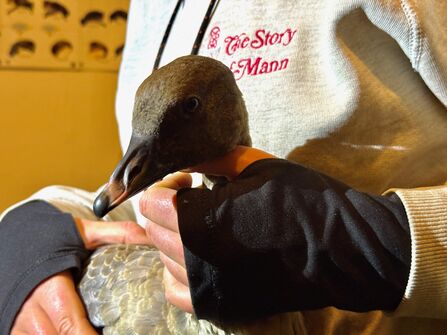
Pink-footed Goose (c)Maia Jones
A late Whitethroat was ringed on the 21st, as well as a few Goldcrest. I also got the pleasure of seeing a new-born seal pup in Mill Giau. This year, all seal pups must be named starting with the letter ‘C’, and a lot of the bays have ‘themes’. Since there are only so many names beginning with ‘C’, the seal team got adventurous pretty quickly, with some fantastic names such as Chainsaw, Clementine, and Captain Hook. The theme for Mill Giau is food, and since I found the pup, I got to name it, so it became Crisp (crispy fresh seal?).
The weather calmed and Dunnocks started to arrive on the 22nd. Good numbers of finches, Robins, and Meadow Pipits making the bulk of ringed birds, and we had our first ‘100 bird day’ of the autumn, which continued the day after. After a productive morning ringing, I had the chance to help with removing some of the sheep from the island.
The Manx Loaghtan sheep—an ancient and rare breed native to the Isle of Man—play a key role in managing the Calf’s grassland habitat. By keeping vegetation short, they help maintain conditions favourable for species like the chough. However, when their numbers grow too high, especially alongside the island’s rabbit population, it can start to cause ecological imbalances. Fortunately, a large part of the flock had been rounded up the day before, making the morning’s task more manageable. Around 60 sheep, including a mix of rams, ewes, and lambs, were ferried off the island over two trips. The remaining animals were tidied up, tagged, and released back onto the island.
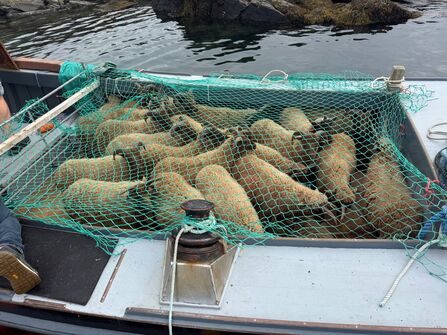
Loaghtan sheep loaded onto the Scraayl ready for transport off the Calf of Man. (c)Maia Jones
After, I chipped in with some pond clearance. A corporate group had volunteered their time for the day, and done a fantastic job of clearing a portion of the horsetail that had been taking over the pond. A quick swim in the evening was a nice end to the day.
A Treecreeper in the net on the 24th was the first Calf record in 2 years, and marked the start of a relatively busy morning. Many Minotaur beetles were being found, and it was enjoyable to see the Buzzards scurrying around the fields feeding on them in the evening. A final session of Manxies on the 25th added one final chick to the months total.
One of the most thrilling surprises of the month was a juvenile Red-breasted Flycatcher on the 28th. I couldn’t believe what I was seeing when I found it in the net! After release, the bird was seen many times with various flocks of migrants, and was even caught again the next day. Of 193 birds ringed, Chaffinch made up the bulk – a whopping 104. This was quickly beaten by 302 birds ringed on the 29th, and included a new Pied Flycatcher and some autumn firsts for the year: Siskin, Coal Tit, and Reed Bunting. The most abundant species was Goldcrest, 79, and a ringed Siskin from Bute was an exciting find.
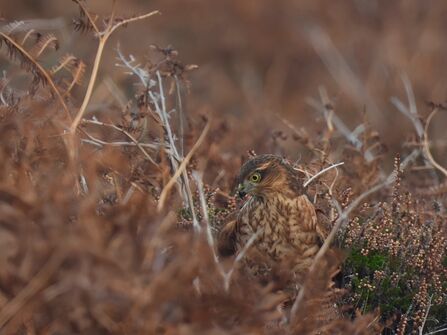
Sparrowhawk in bracken. (c)Maia Jones
It’s safe to say I was genuinely sad to leave – especially after such an incredible final few days. Not only did I have an amazing time, but I also gained so much insight into island life, the inner workings of the observatory, and witnessed migration in a way I never had before. Being able to ring and birdwatch daily was a rare privilege, and I already miss it deeply as I sit here reflecting on the past month.
This experience gave me so much to take away, both personally and professionally. I feel especially grateful to have been assessed for my C-Permit for mist netting while on Calf – a huge thank you to Eleanor for passing me and for sharing so much knowledge along the way!
I’ll absolutely be recommending the seasonal volunteer role on Calf to fellow birders and ringers who are keen to embrace island life, explore new ringing techniques, and get involved in long-term data collection. I’m incredibly thankful for the opportunity and couldn’t be more appreciative of the team – wishing you all the very best for the rest of the season!

